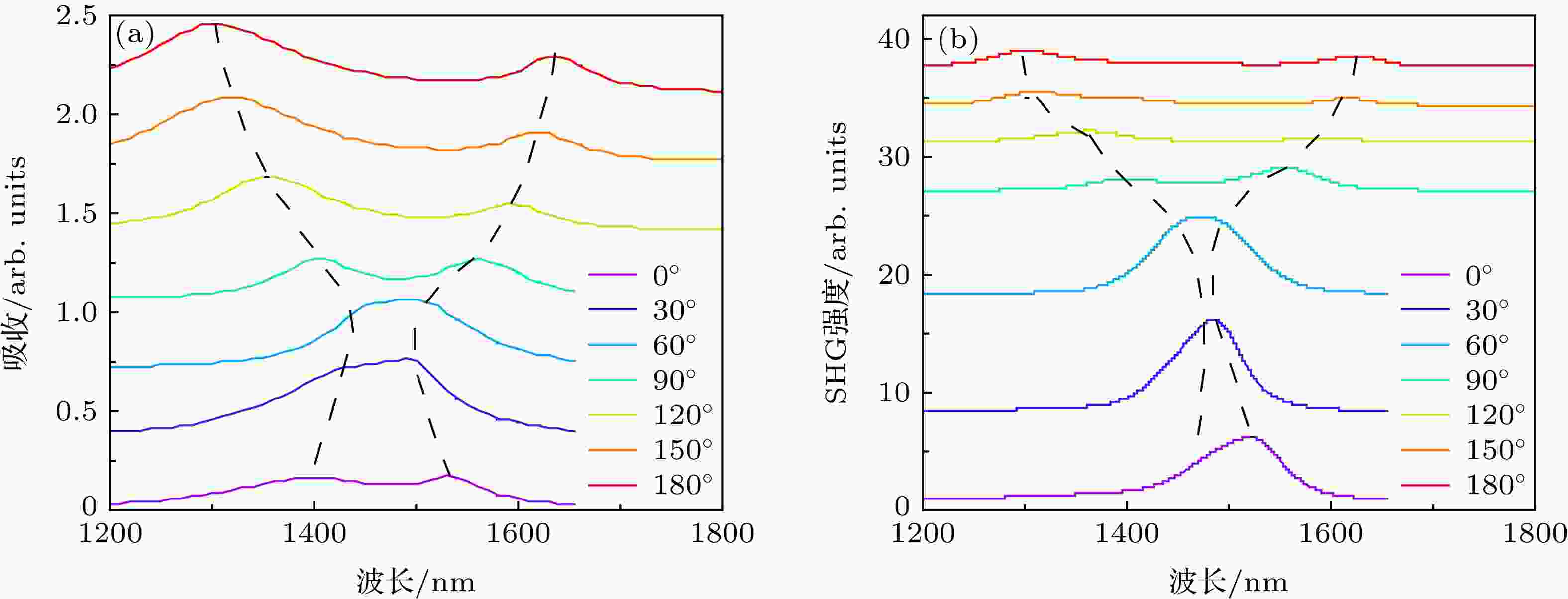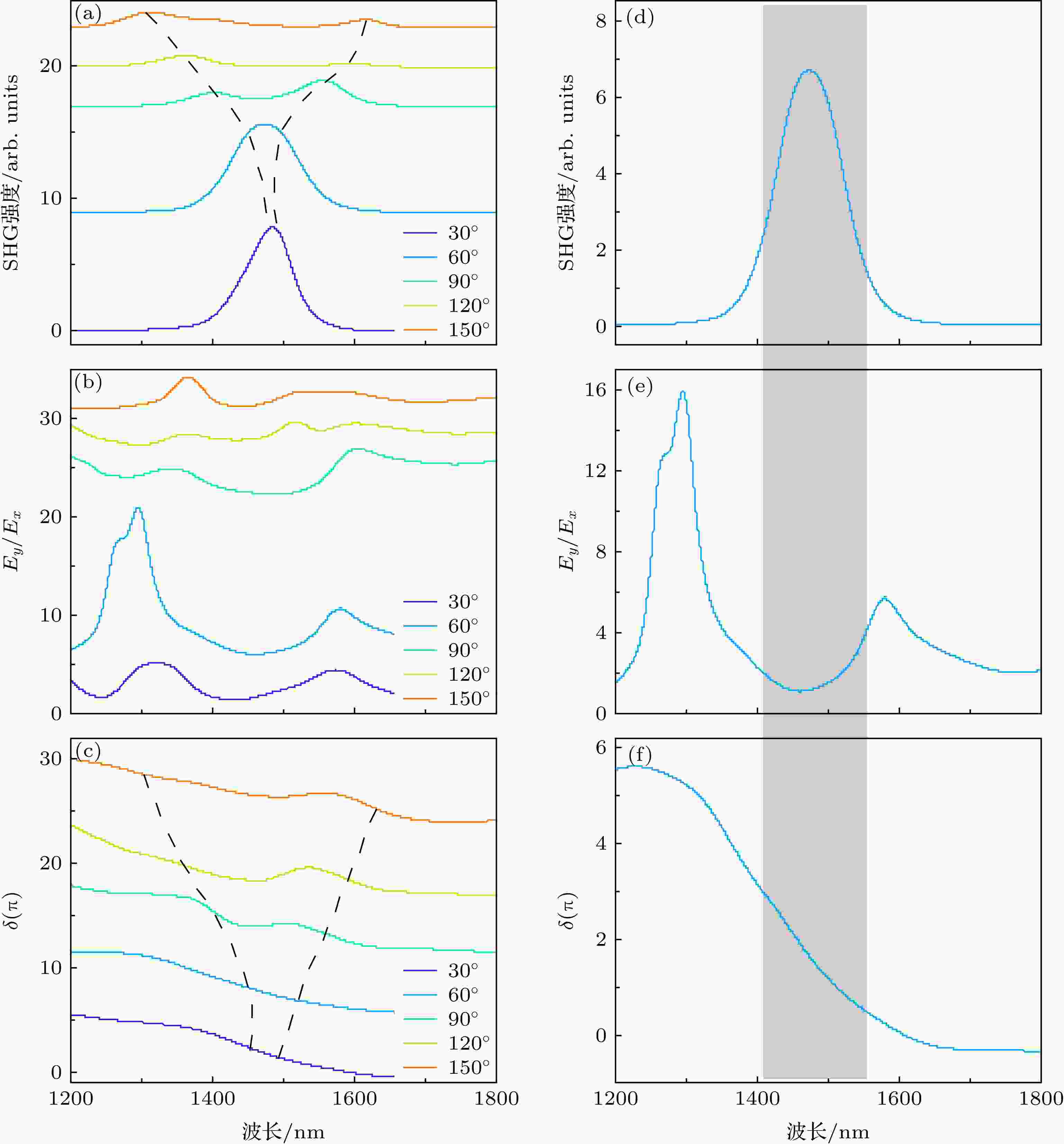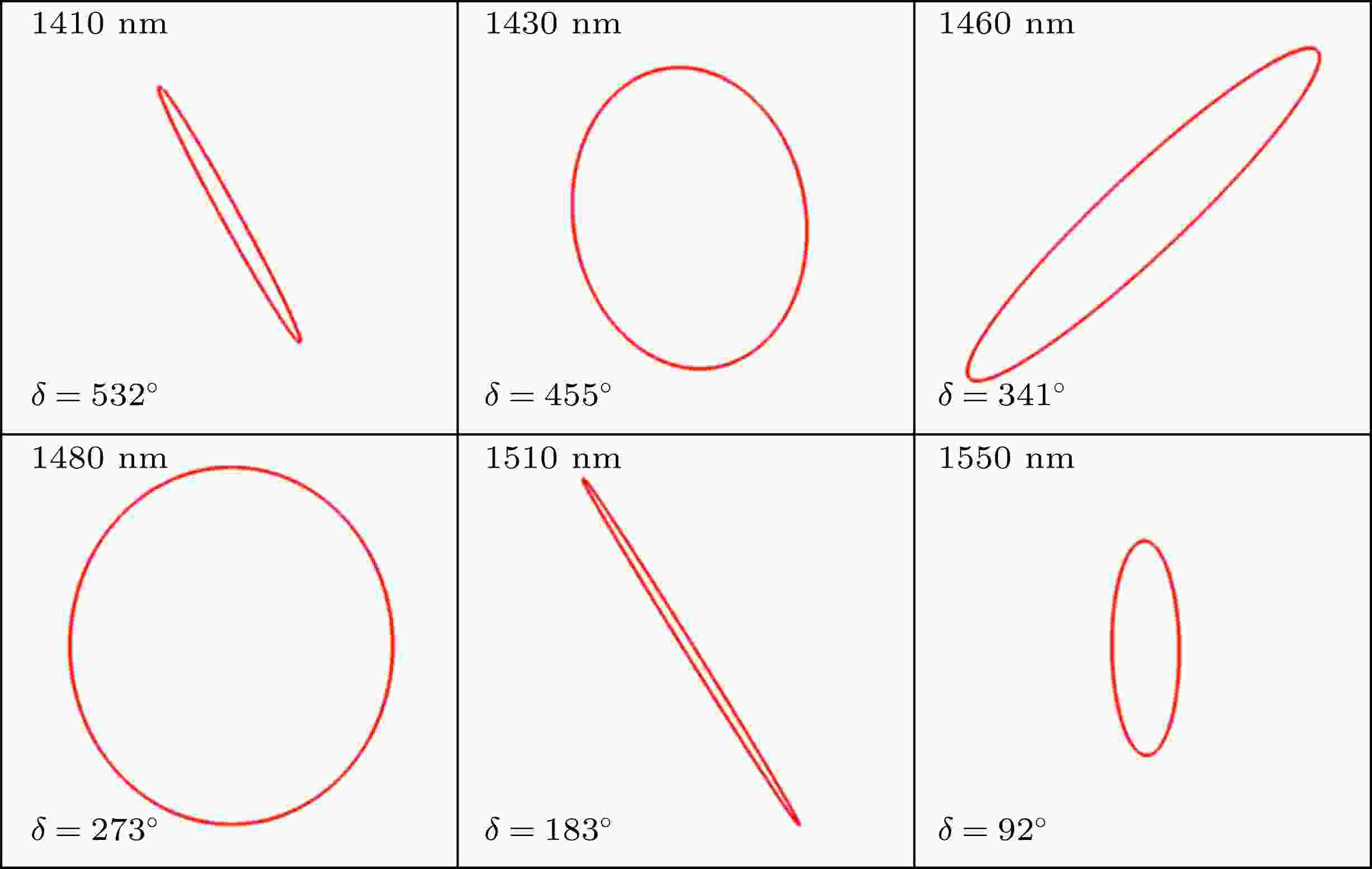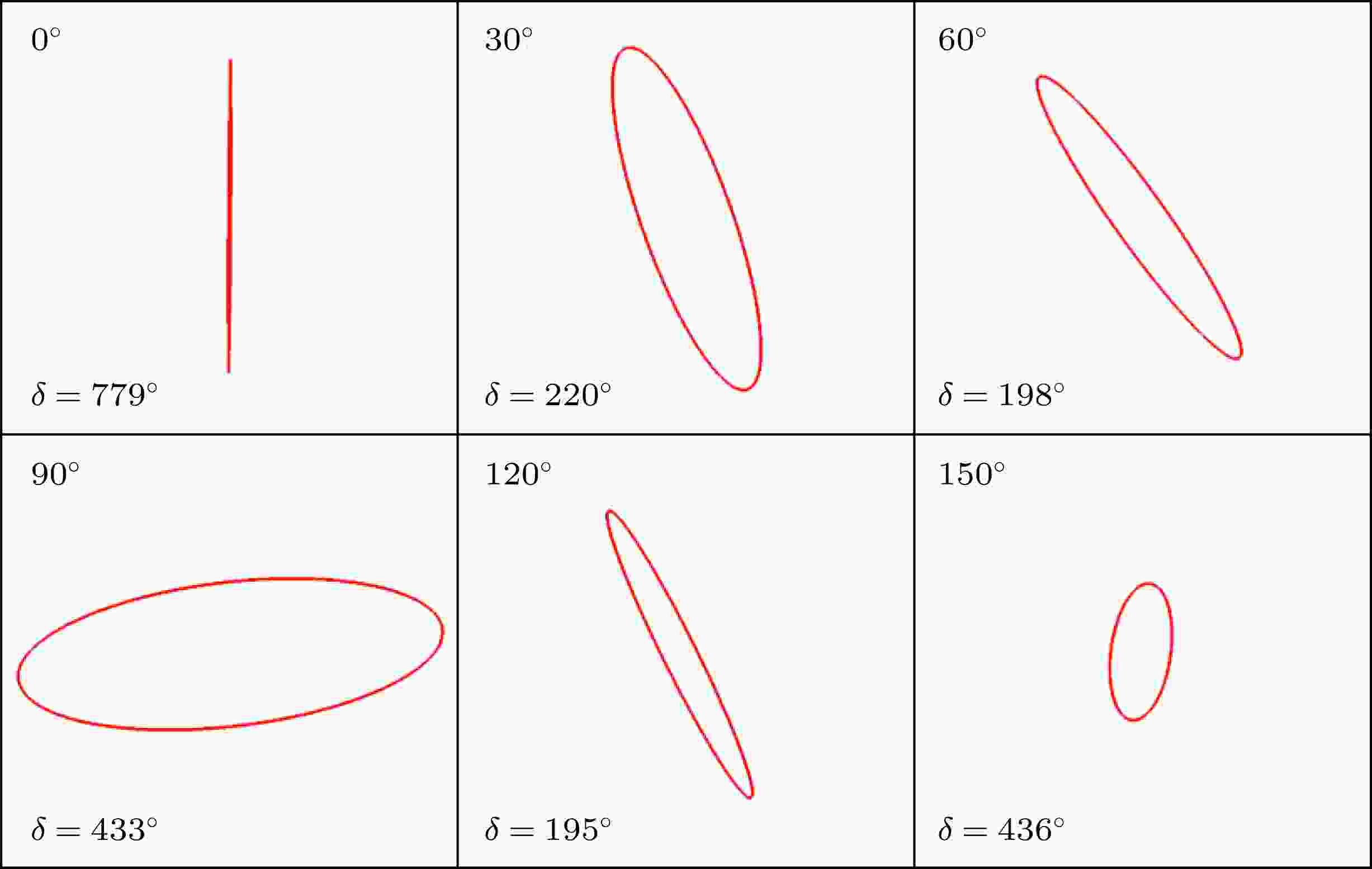全文HTML
--> --> -->在光波的波前调控领域, 对于偏振调控, 目前主要还是集中于用波片、偏振片或者相位延迟器等宏观的器件来实现. 为了实现集成光学的效果, 人们提出了一些基于微纳材料的二维结构来调控光的偏振态[6—10]. 比如, 在线性领域, L形金属纳米线由于对称性的破缺, 在正交方向上能产生不同频率的共振, 那么反射光在正交方向上的相位差和电场会随着纳米线的旋转而独立变化, 所以就可以用来调节反射光的偏振态[11]. 或者采用两组亚单元的组合, 分别在正交方向上产生相应的线偏振光, 再通过亚单元之间的空间位错引入相位差, 从而将入射的线偏振光转化为各种椭圆偏振态[12]. 另外, 还可以采用双圆形开口环的立体结构组成一个手性超分子, 它会在与入射偏振正交的方向上引入共振, 从而在不同波长下产生不同偏振态的透射光[13]. 总之, 偏振调控的关键在于如何在两个正交方向上引入相位差. 但目前偏振调控还多局限在线性领域中的实现, 至于如何在非线性领域调控二次谐波(second harmonic generation, SHG)的偏振态, 目前鲜见报道.
微纳尺度下, 两个结构单元之间的耦合效应对于其模式特性起到了至关重要的作用[14—18]. 超材料在光学频段既有电共振特性, 又有磁共振特性[19], 所以电和磁的偶极子以及更高阶的多极子之间的耦合是其中的重要机制. 耦合体系内部不同的耦合形式可以帮助我们很好地理解从分子态到固体物理模型的演变. 由于超材料的体积小于光的波长, 材料内部的两个结构单元之间相互作用就会极大地增强[20]. 每个微纳尺度的亚单元可以看成一个“超原子”, 它们的组合构成“超构分子”的过程中, 由于电磁耦合作用, “超原子”不同的排列方式或相对位置会带来“超分子”不同的光学特性的改变[21], 这就为研究模式耦合及其应用带来了更多的调控自由度.
金属开口环谐振器(split ring resonators, SRR)由于在共振时表面存在环形电流[22], 相当于一个磁偶极子, 所以可以看成一种磁性“超原子”. 本文研究了由两个SRR堆叠构成的立体超构分子中的SHG特性. 相比于单个SRR仅能产生电场沿着其臂的方向振动的线偏振SHG[23], 在SRR超构分子中利用两个开口环超原子之间的耦合, 通过其开口方向的旋转可以引入电场在正交方向振动的两个SHG分量, 并且可以调控正交分量之间的振幅比和相位差, 从而可以获得具有不同偏振态的SHG辐射.






 图 1 (a)由两个金属SRR上下堆叠组成的超构分子结构示意图; (b)上下两个SRR相对开口朝向夹角为φ = 90°时超构分子的吸收谱; (c)与吸收谱中两个吸收峰对应的波长wl1和wl2处SRR表面的磁场垂直分量Hz分布图
图 1 (a)由两个金属SRR上下堆叠组成的超构分子结构示意图; (b)上下两个SRR相对开口朝向夹角为φ = 90°时超构分子的吸收谱; (c)与吸收谱中两个吸收峰对应的波长wl1和wl2处SRR表面的磁场垂直分量Hz分布图Figure1. (a) Schematic diagram of SRR-based meta-molecule; (b) absorption spectrum of the meta-molecule consisting of two SRRs with a twist angle φ = 90°; (c) distributions of magnetic field component Hz on the surface of the SRRs at wavelengths corresponding to two absorption peaks wl1 and wl2.
 图 2 双层相对角度改变时, (a)吸收谱和(b) SHG强度的变化, 黑色划线代表每条线左右峰值的连线
图 2 双层相对角度改变时, (a)吸收谱和(b) SHG强度的变化, 黑色划线代表每条线左右峰值的连线Figure2. (a) Absorption spectrum and (b) the SHG intensity with the relative angle of the two layers changing. The black dash line represents the line connecting the left and right peaks of each line.
我们知道单个SRR结构在入射基波偏振沿着其底边方向时, 所产生的SHG也是一种线偏振, 并且电场振动方向与SRR底边相垂直, 即沿着SRR臂的方向. 而在由两个SRR组成的超构分子中, 我们已经在图1中展示了即使下层SRR无法被入射基波直接激发的情况下, 也可以通过先激发上层SRR的磁共振模式, 继而通过模式耦合作用从而将下层SRR的磁共振模式激发出来. 由于SRR中SHG辐射的电场振动方向是与其臂的方向平行的, 因此在我们研究的超构分子中, 上层SRR将提供SHG的y分量, 而调节下层SRR的开口方向, 使得上下两个SRR的开口朝向夹角不为0°或180°时, 下层SRR产生的SHG就会具有x分量, 这就为调控SHG的偏振态提供了一个可能的途径.
我们选取相对角度从30°到150°每隔30°变化的5个参数, 分别给出了这五种结构下的远场SHG强度、SHG辐射的y和x分量的振幅比Ey/Ex和相位差δ, 如图3(a)—(c)所示. 可以看到, 由于下层SRR的开口偏离了y轴, 引入了SHG在x方向的电场分量, 因而SHG在两正交方向上的电场不再以y分量为主导, 振幅比Ey/Ex总体在1左右变化. 与此同时, SHG辐射的电场两正交分量之间的相位差δ在所选波段内都有比较大的变化.
 图 3 双层相对角度为30°—150°时的远场SHG强度 (a)、SHG辐射的y和x分量的振幅比Ey/Ex (b)和相位差δ (c)随着波长的变化; 双层相对角度为60°时的远场SHG强度 (d)、SHG辐射的y和x分量的振幅比Ey/Ex (e)和相位差δ (f)随着波长的变化; 其中阴影区域表示SHG效率较大的一段波长区域
图 3 双层相对角度为30°—150°时的远场SHG强度 (a)、SHG辐射的y和x分量的振幅比Ey/Ex (b)和相位差δ (c)随着波长的变化; 双层相对角度为60°时的远场SHG强度 (d)、SHG辐射的y和x分量的振幅比Ey/Ex (e)和相位差δ (f)随着波长的变化; 其中阴影区域表示SHG效率较大的一段波长区域Figure3. When the relative angle of the two layers changes from 30° to 150°, (a) SHG intensity, (b) amplitude ratio of SHG in the y and x directions and (c) the phase difference of SHG in the y and x directions as a function of wavelength; when the relative angle of the two layers is 60°, (d) SHG intensity, (e) amplitude ratio of SHG in the y and x directions and (f) the phase difference of SHG in the y and x directions as a function of wavelength. The shaded area indicates a wavelength region where the SHG efficiency is relatively large.
值得一提的是, 不同角度下SHG在y和x方向上的相位差随波长变化的斜率有所不同, 且对于吸收谱明显劈裂为两个共振峰的90°, 120°, 150°, 相位差存在两次斜率较大的变化, 由图3(c)中黑色辅助线可以看出, 这两次明显变化对应的波长与各自线性谱的两个峰位是符合的. 而在两峰位之间相位差的变化则相对比较平缓, 这说明共振会带来相位差的较大变化. 这是由于双层SRR之间的耦合作用在磁共振时会得到极大的增强, 能量就从上层SRR转移到下层SRR. 而两层SRR分别提供SHG沿着开口方向上的分量, 所以y和x方向上的相位差会受到共振明显的调制.
为了实现SHG辐射较为丰富的偏振态, 要在保证固定波段内SHG效率的前提下, 尽量让两正交方向的振幅比Ey/Ex接近于1, 同时相位差δ能有较大的变化. 综合考虑这些因素, 我们以上下夹角为60°的双层SRR为例来展示可以获得的SHG偏振态. 把其对应的远场SHG强度、SHG辐射的y和x分量的振幅比Ey/Ex和相位差δ在图3(d)—(f)中单独显示, 发现超构分子在1410—1550 nm这段基波波长范围内都具有较高的SHG效率, 且SHG在y和x分量间的振幅比在1—4之间变化, 相位差也具有超过360°的全相位变化.
那么有了SHG两个正交分量的相位差和振幅比的信息, 就可以得出SHG偏振态. 对于一个面向波的传播方向的观察者来说, 传播的电场在两个正交方向上的分量会遵循这个经典的关系式:
 图 4 双层相对角度为60°、不同波长的基波入射时, 远场SHG偏振态的变化
图 4 双层相对角度为60°、不同波长的基波入射时, 远场SHG偏振态的变化Figure4. Polarization of the far-field SHG changes when the relative angle of the two layers is 60°, and the the fundamental wave of different wavelengths is incident.
另外, 非线性偏振转换器件的工作环境有时需要固定基波波长就可以产生不同偏振态的非线性信号. 于是又按照图3选取了固定的基波波长1500 nm, 根据此波长处不同角度时的SHG强度和振幅比, 求出了不同角度下SHG的两个正交电场分量Ey和Ex, 并和相应的相位差δ一起代入(1)式. 再导入数值计算软件Matlab, 得到了固定波长下, 远场SHG偏振态随相对角度的变化, 结果如图5所示. 可以看出, 随着双层SRR相对角度的变化, 固定的基波激发出的SHG椭圆偏振态的长轴发生了旋转, 展示了近线偏振和椭圆偏振态的变化.
 图 5 基波波长为1500 nm入射时, 不同相对角度的结构的远场SHG偏振态的变化
图 5 基波波长为1500 nm入射时, 不同相对角度的结构的远场SHG偏振态的变化Figure5. When the incidentwavelengthis 1500 nm, the polarization of the far-field SHG changes with the relative angle of the two layers
